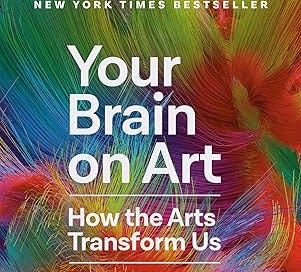Two posts ago I shared the audio of a panel discussion on Immersive Wellness for Expanding Aliveness that I participated in at South by Southwest. One of the reasons I was excited to be there was to finally meet Susan Magsamen, Executive Director of International Arts + Mind Lab at Johns Hopkins University and coauthor of the terrific book Your Brain on Art: How the Arts Transform Us.
It’s a beautifully written compendium of the science of neuroaesthetics
I’ve known her co-author Ivy Ross, the Chief Design Officer for consumer devices at Google, for a long time (although we have yet to meet – so looking forward to that too!). The two of them created a beautifully written compendium of the science of neuroaesthetics, encompassing research into how the human brain responds to art, architecture, reading, and so many other stimuli, showing how our response changes us. As they open the book:
You know the transformative power of art. You’ve gotten lost in music, in a painting, in a movie or play, and you felt something shift within you. You’ve read a book so compelling that you pressed it into the hands of a friend; you heard a song so moving, you listened to it over and over, memorizing every word. The arts bring joy. Inspiration. Well-being. Understanding. Even salvation. And while these experiences may not be easy to explain, you have always known they are real and true.
While much of the experiences discussed are transporting, not transformative – changes in state, not in identity – just one example of many transformation exemplars that could be cited is the work of David Putrino, Director of Rehabilitation Innovation at Mount Sinai Health System (see pp. 113-6). He “marries aesthetics and the arts with technology to treat people who have suffered serious injury or illness such as stroke, ALS, and traumatic brain injury”. Through the use of neuromodulation – using technology to provide sensory input that stimulates the nervous system – Dr. Putrino uses art across “the full spectrum, from Olympians at the pinnacle of human performance all the way through to those locked-in with ALS” and works to create “optimal human performance.” He says, “You shouldn’t just rehabilitate a stroke survivor to the point they were at before they had the stroke, you should be pushing them along the wellness spectrum, beyond where they were.”
This is just a small taste of the research and examples Susan and Ivy share throughout the book – I have scores of Post-It Notes hanging out of the side and top of my copy! – and love that they devote an entire chapter to human flourishing.
When I picked up my copy, given its focus on art I expected it to be THE book on the esthetic realm of experience and help show the way to how the esthetic realm manifests itself with transformations, which it absolutely is and does. But I was surprised at how so much of the book applied to the other three realms of experience (entertainment, educational, and escapist). As just one example here, Magsamen and Ross report on Adam Gazzaley, Executive Director of Neuroscape at the University of California, San Francisco, Medical Center (see pp. 154-7). Focusing on ADHD, Dr. Gazzaley and his team worked on immersive videogames to improve user attention. The games would start easy and get harder as players with ADHD played. One such game, “called EndeavorRx, was approved by the FDA as a Class 2 medical device to treat children with ADHD”.
I highly recommend you give it a read!
Whether or not you’re involved in art or know anything of neuroscience, you will find much here related to transformations, and I highly recommend you give it a read.
Joe Pine
© 2025 B. Joseph Pine II





